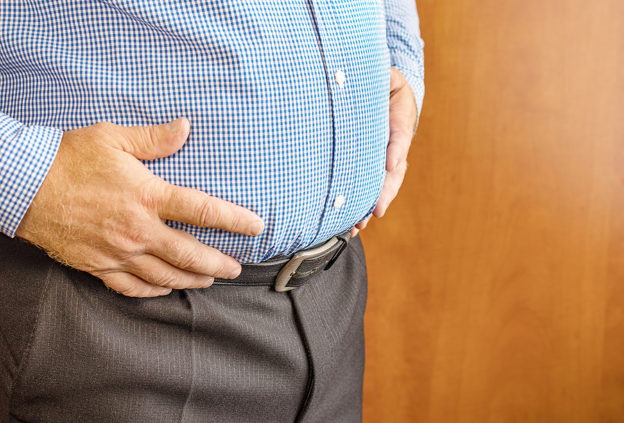By David Blyweiss, M.D., Advanced Natural Wellness
July 14, 2021
It’s not only the overweight and obese who are carrying around excess abdominal fat. Even people with a “normal weight” BMI can have excess fat, especially in the abdomen.
There are plenty of names for it. Visceral fat. Intra-abdominal fat. Central obesity. Belly fat.
This type of fat is harmful. It wraps around vital internal organs – like the pancreas, liver, and intestines – and chokes them off. It raises your chances of cardiovascular disease, type 2 diabetes, Alzheimer’s disease and other serious health conditions. It also increases the risk of early death.
The thing is, people with a normal BMI can have central obesity. And they are at just as much risk of these negative health outcomes as people who have an overweight or obese BMI.
So when it comes to whether you are carrying around too much belly fat, BMI is absolutely useless.
MD Exposes the Hidden Danger to Your Eyes

When your eyesight starts to fail, it's a real problem. Suddenly you can't go to the grocery store... you can't get to the doctor if you have an emergency... you can't meet your friends for dinner…
Your "regular" doctor doesn't have time to keep up with the latest research. And the same goes for eye doctors. They go to school to learn how to fit you for glasses and contacts, but have no way of preventing the damage and loss of eyesight that threatens your freedom and independence.
Let me show you something that explains a LOT about how your eyes work.
In my FREE Special Report, I'll show you a HUGE, untapped resource for your eyes that safely and naturally restores clear, effortless eyesight.
Click here to get started...
Of course, looking in the mirror can be a dead give-away. If your belly is nearly the same size as your hips, or larger, then you’re definitely seeing some central obesity going on. But there are a couple of different measurements you can take to find out for sure.
Find Out if You have too much Belly Fat
It’s not very often we can predict disease, especially when someone appears to be a healthy, normal weight. But if you have abdominal obesity – and you know you have it – you can do something about it before the health consequences strike.
There are two different ways to measure your risk.
The first is the waist-to-hip ratio.
You simply measure your waist at its smallest circumference. Next, measure the widest area of your hips. Write those numbers down. Then plug them into a waist-hip-ratio calculator to find out where you fall. If you are in the moderate or high-risk category, it’s important that you start making some changes in your life.
Any number above 0.90 in men and 0.80 in women increases the risk of developing a serious health condition. The higher the number, the greater the risk.
The second measurement is the waist-to-height ratio.
The World's Quickest Solution for Ending Prostate and Urinary Misery
This has recently been revealed to be one of the only real breakthroughs in prostate health.
The seeds of a strange fruit (sometimes called "Chinese Apples") hold powerful phytonutrients that are a revolution in prostate health.
In fact, UCLA and Veterans Administration research have now proved this to be true.
Not only that, but it may be the worlds quickest solution for ending prostate misery.
Simply stated, these phytonutrients represent a huge step beyond beta sitosterol, saw palmetto, and other phytosterols alone.
Simply click HERE if you want to have fast prostate relief...restful, uninterrupted sleep...no more constant "urges to go"...enhanced virility...and optimal prostate support for life.
The concept is very similar. Measure your waist at its smallest circumference, then measure your height. Put those numbers into a waist-height-ratio calculator and it will tell you where you stand.
The number should be lower than 0.50. The higher the number beyond that, the more chances of developing life-altering health problems and losing years of life.
If either or both of these numbers is high, it’s a call to action.
How to Target Visceral Fat
Here’s something that might sound strange. You don’t actually have to lose weight to target the fat that strangles your organs. But you do need to lose inches. Every five centimeter reduction in waist circumference can reduce the chance of early death by as much as 9% over six and a half years – at any level of BMI!
It turns out that exercise has a huge impact on visceral fat, even without weight loss. For some reason, visceral fat is preferentially targeted during exercise. In the absence of weight loss, exercise is related to about a 6% decrease in visceral fat.
The type of exercise isn’t nearly as important as getting moving. Start by taking long walks. Pick it up to a brisk walk or jog for a minute or two every now and then. Strength training is great, too. Even things like tai chi and yoga can help.
In fact, just recently a group of people with central obesity took 12 weeks of tai chi. All of them were over 50 years of age, so they weren’t spring chickens. But they managed to lose an average of 1.8 cm in waist size. (Remember! Every centimeter off the waist counts when it come to reducing the chance of early death.)
Keep in mind that you can exercise all day long, but if you don’t eat a healthy, anti-inflammatory diet it could all be for naught. So make sure to move frequently and eat well.
SOURCES:
Bosomworth NJ. Normal-weight central obesity: Unique hazard of the toxic waist. Can Fam Physician. 2019;65(6):399-408.
De Lorenzo A. Normal-weight obese syndrome: early inflammation? American Journal of Clinical Nutrition. 2007; 85:40-45.
Romero-Corral A. Normal weight obesity: a risk factor for cardiometabolic dysregulation and cardiovascular mortality. European Heart Journal. 2010;31:737-746
Mark Hamer, G. David Batty. Association of body mass index and waist-to-hip ratio with brain structure. Neurology. 2019.
Ashwell M, Mayhew L, Richardson J, Rickayzen B (2014) Waist-to-Height Ratio Is More Predictive of Years of Life Lost than Body Mass Index. PLoS ONE 9(9): e103483.
Verheggen RJ, Maessen MF, Green DJ, Hermus AR, Hopman MT, Thijssen DH. A systematic review and meta-analysis on the effects of exercise training versus hypocaloric diet: distinct effects on body weight and visceral adipose tissue. Obes Rev. 2016 Aug;17(8):664-90.
Siu PM, Yu AP, Chin EC, Yu DS, Hui SS, Woo J, Fong DY, Wei GX, Irwin MR. Effects of Tai Chi or Conventional Exercise on Central Obesity in Middle-Aged and Older Adults : A Three-Group Randomized Controlled Trial. Ann Intern Med. 2021 Jun 1.







